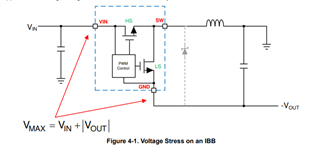Other Parts Discussed in Thread: TPS62480,
Tool/software:
Hello, I found this reference: https://www.ti.com/lit/an/slva458b/slva458b.pdf?ts=1722951618887 that a buck regulator can be converted to a buck-boost and made into an inverting power supply. I'm wondering if the TPS62480 can be used in the same way, where the positive output is tied to ground with the chip ground tied to the negative output rail.
I suspect the answer is no because of the additional zeros in the transfer function of the buck boost, but wondering if an engineer can comment on this or if anyone has done it before. I need the TPS62480 for its ultra low quiescent current but I also need a dual supply (+0.9V and -0.9V).




